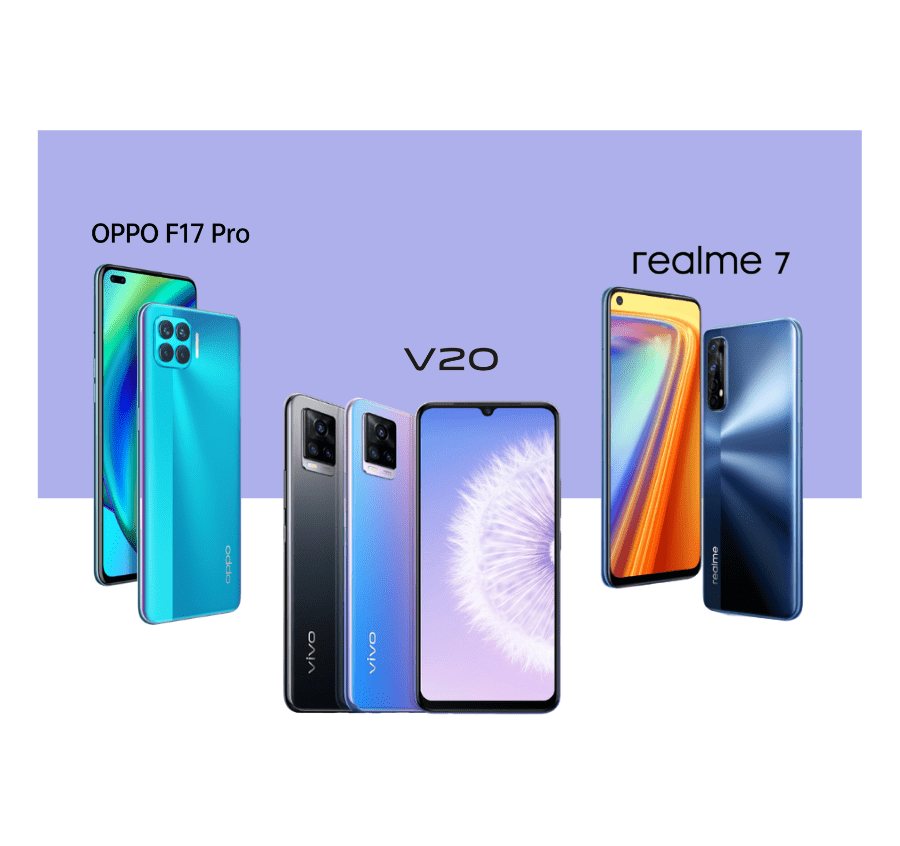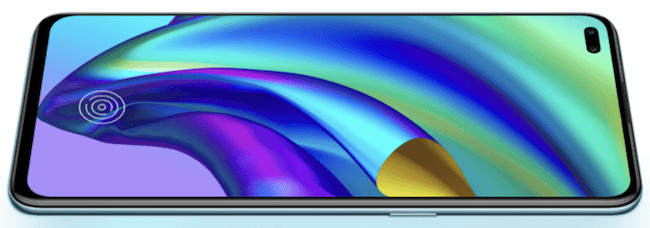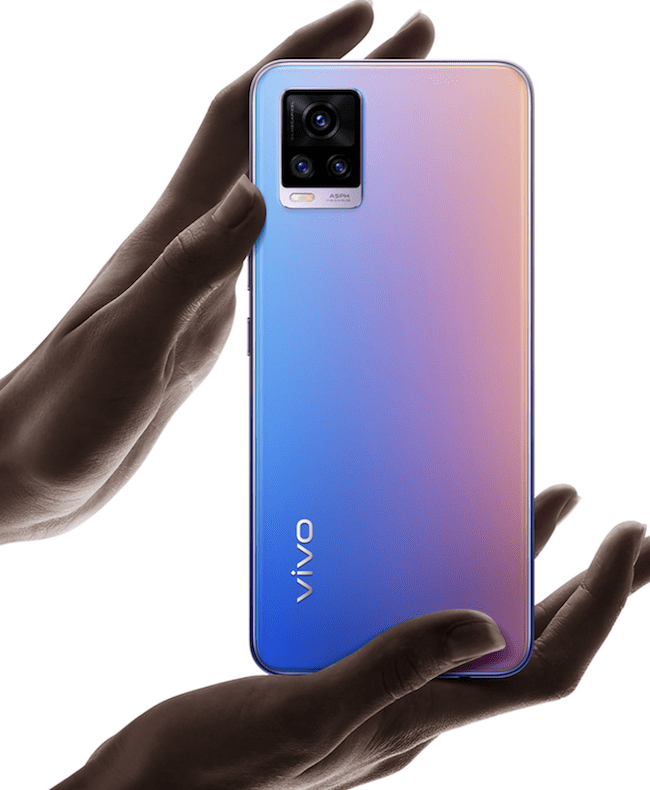Oppo F17 Pro vs Vivo V20 vs Realme 7: Which one is better?

BBK Electronics Corporation remains one of the world’s largest manufacturers. They market smartphones under Oppo, Vivo, and Realme among others. Despite having the same manufacturer, these three brands compete against each other when it comes to affordable smartphone choices. Given their huge success, let us pluck out one of the most popular devices among these three brands. This, of course, includes OPPO F17, Vivo V20, and Realme 7.
Oppo F17 Pro vs Vivo V20 vs Realme 7: Which one is better?
Oppo F17 Pro
Design and display
Design and display are two of OPPO F17 Pro’s strong suits. It wouldn’t surprise anybody if a lot of people would buy the handset solely for its design. It also feels comfortable to use for long periods whether or not it comes with gaming or texting. Built from plastic, it looks delicate at first, especially with its Magic Blue color that looks great under the sunlight. Then, you can see hints of purple along the edges.
Performance and software
It has a 6.43-inch Super AMOLED display with a Full-HD+ resolution and a maximum brightness of 800nits. With daily usage, it also feels snappy and responsive when loading apps. It works decently well and could remain handy when answering a call without touching the phone with a new gesture called ‘Air Answer.’ Aside from that, watching videos on the display remains a good experience as it becomes punchy and the brightness levels are more than adequate.

Battery life
The 4,015mAh battery life lasts for a day and a half of medium to light usage on average. When playing an HD video on a loop, it lasts for sixteen hours and forty-eight minutes. It has a 30W fast charging and will become fully charged under an hour.
Camera
When it comes to cameras, on the other hand, the OPPO F17 Pro does fairly okay. In daylight, it captures sharp and well-detailed 12-megapixel binned images. The exposure and colors were also handled very well. Without any unwanted boost in saturation, the autofocus remains reliable as it captures close-ups quite easily. However, the camera goes weaker with low-light situations despite the camera app’s night mode.

Vivo V20
Design and display
Vivo focused on design with the V20 became evident as they had eye-catching appeal with the handsets. It remains slim and has rounded corners for the user’s comfortability. It also has a 6.44-inch AMOLED display, 20:9 aspect ratio, and a Full HD+ resolution. Aside from that, it has a dewdrop notch on the V20. Available in Moonlight Sonata, Midnight Jazz, and Sunset Melody, the frame is made out of plastic and the back panel has been made out of glass.
Performance and software
The crisp AMOLED display remains very good for watching videos. It has a high-refresh-rate panel where any user can tweak the color mode of the display and set the color temperature based on their preference. Users can game and multitask quite easily without any lag or stutter. Aside from that, the gaming performance also remains decent. However, the phone becomes slightly warm to the touch after gaming, but not to an alarming degree. Casual games, on the other hand, ran fine without any issues.

Battery life
In the quest for battery life, smartphones have become big and bulky with 4,000mAh. However, with Vivo V20, the brand shrunk internal components and used a high-density battery to shave off a few millimeters. As a result, the V20 now has 7.38mm in thickness. It went on for over a day on a single charge. When a video looped as a test, the handset lasted fourteen hours and thirty-nine minutes. Supplied with a 33W FlashCharge charger, the V20 became fully charged after an hour.
Camera
The V20 remains selfie-focused. It has used a triple-camera setup on the rear of the handset with a 64-megapixel primary camera, and an 8-megapixel wide-angle camera. It also remains a 44-megapixel selfie shooter with Eye Autofocus. Aside from that, it also has different shooting models that remain well laid out. The photos shot in a bright sunny condition turned out well with accurate colors. The wide-angle camera, on the other hand, managed decent quality. However, the output isn’t as sharp as that of the primary camera. Meanwhile, the lack of detail didn’t come as evident when zooming in. Impressively, the camera fares well in low-light situations.

Realme 7
Design and display
Dubbed to have a ‘somewhat new’ design and display, Realme 7 has a fresh design compared to its older sibling, Realme 6. It also features a mirror-split design creating some interesting patterns when light hits. Overall, the handset also looks fresh and new from the back. Compared to its predecessor, the newer model became thicker with 9.4mm and heavier with 196.5g due to its larger battery. Feeling well-built and sturdy, it uses plastic for the frame and back panel.
Performance and software
The performance remains pretty satisfactory. The Realme 7 used Realme UI that remains based on Android 10. And, it worked smoothly. Meanwhile, navigating through the interface felt snappy. Aside from that, the mobile apps generally went quick to load. The 90Hz refresh rate also made scrolling through menus feel smooth. When playing games, on the other hand, it performs well that looked great at the highest graphics settings.

Battery life
The 5,000mAh battery becomes a big upgrade over its predecessor’s 4,300mAh capacity. With medium to heavy usage, the Realme 7 can get a day and a half runtime on one charge. With an HD video battery loop test, the handset lasts a little over a day which remains excellent. Thankfully, using a 15W USB-C Power Delivery fast charging, the battery can charge quickly, too.
Camera
Using a new “ultra high definition” algorithm for the 64-megapixel mode, it promises better clarity and detail compared to the sensor on its predecessor. It captures a cleaner image with less grain, but textures remain heavily smoothened. Aside from that, it also retains better textures. Default photo mode has a noticeable improvement in pixel-binned images. The camera also fares well in low-light situations. Meanwhile, night mode makes the photos cleaner.

Overall Comparison
Oppo F17 Pro’s compact design, thin and lighter weight, dual-front camera, and AMOLED display became its biggest advantages. Unfortunately, its inferior hardware falls short of the other two. Vivo V20, on the other hand, can be applauded with its AMOLED display, faster charging, great hardware, nice cameras, while being thin and lightweight. However, it has a smaller battery that could become a problem when users need it for a longer time. Meanwhile, Realme 7 has 90Hz, a great chipset, worldwide availability, and a bigger battery that can remain useful for many. Its dimensions, unfortunately, become the only con for this handset.
Oppo F17 Pro vs Vivo V20 vs Realme 7: Which one do you think is better for you? Let us know!
Angela Grace P. Baltan has been writing professionally since 2017. She doesn’t hesitate to be opinionated in analyzing movies and television series. Aside from that, she has an affinity for writing anything under the sun. As a writer, she uses her articles to advocate for feminism, gender equality, the LGBTQIA+ community, and mental health among others.





